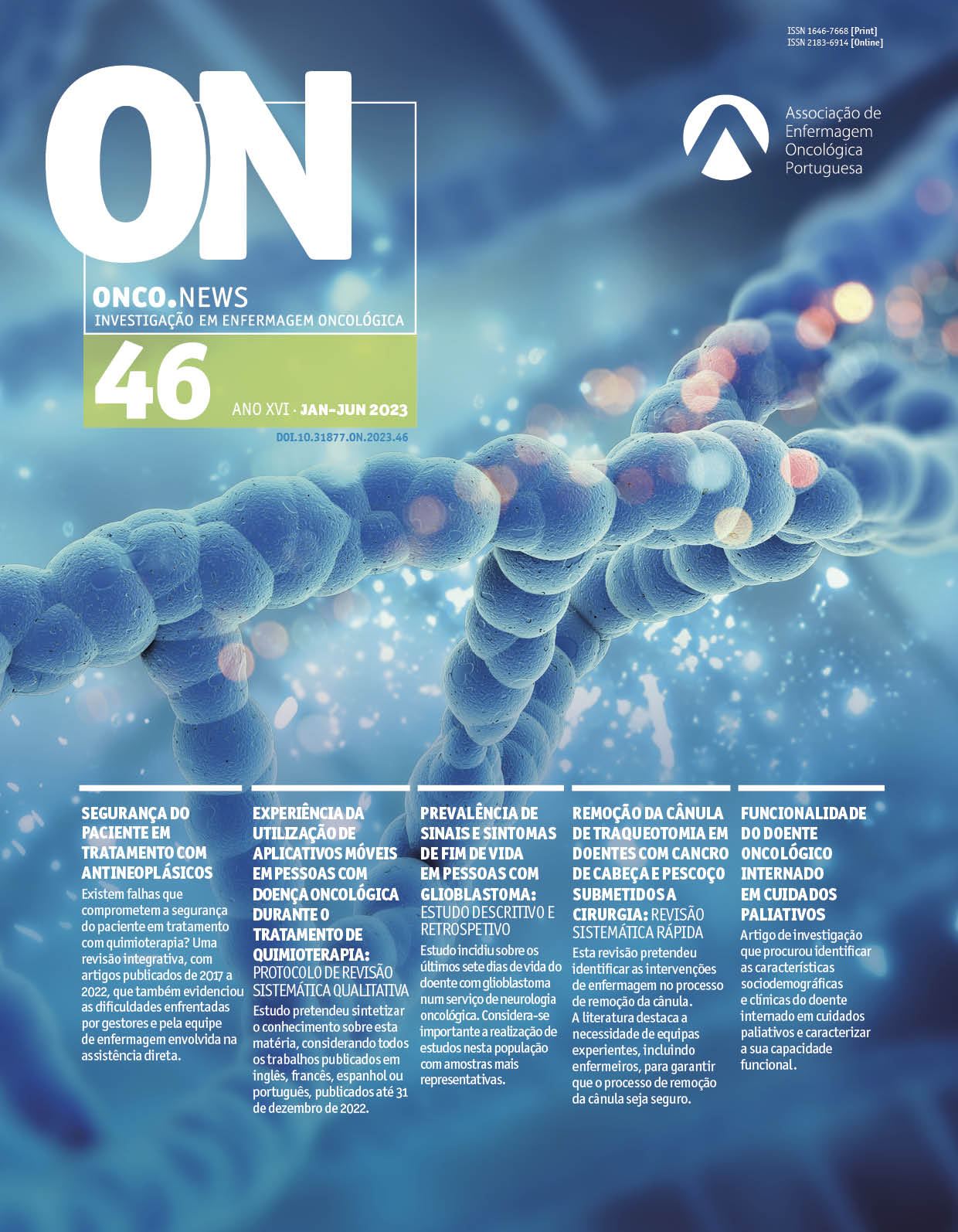Signs and Symptoms in the last days of life of the glioblastoma patients – A Descriptive and Retrospective Study
DOI:
https://doi.org/10.31877/on.2023.46.03Keywords:
Fim de vida; Glioblastoma; Cuidados PaliativosAbstract
Background: Having a glioblastoma is still a synonym of a very poor prognosis. In this population, end-of-life signs and symptoms differ from the rest of the cancer population
Objective: To identify the main signs and symptoms that occur in patients with glioblastoma in their last seven days of life in a neuro-oncology ward.
Methods: Descriptive and retrospective study. Sample composed of people with glioblastoma in the last seven days of life, hospitalized in the neurology ward, with medical and nursing records. Admittion in the institution through neurooncology consultation between 2019/2020. Data collection was performed through patient’s clinical records analysis.
Results: The sample has 17 people. The most prevalent signs and symptoms were: “decreased level of consciousness” (94%); “rare and unexpected events”
(94%); “respiratory dysfunction” (88%) and “loss of ability to swallow” (76%).
Conclusions: The study allowed responding to the research objective. The results underline the importance of carrying out studies with more representative samples, given that most studies are found to be focused on the cancer population in general.
Downloads
References
Organização Mundial da Saúde. Globocan: Portugal in 2020 [Internet]; 2020 [Acedido em Abril 2021]. Disponível em:
https://gco.iarc.fr/today/data/factsheets/populations/620-portugal-fact-sheets.pdf.
Abrey L., Mason W. Fast Facts: Brain Tumors. Oxford: Health Press Limited; 2011. p. 144.
Louis, D., et al. The 2016 World Health Organization Classification if Tumors of the Central Nervous System: a summary. Acta Neuropathol. 2016; 131(6): 813-820.
Bi W., Beroukjim R. Beating the odds: extreme long-term survival with glioblastoma. Neuro-oncology. 2014; 16(9): 1159-1160.
Kuchinad, K. et al. End of life care for glioblastoma patients at a large academic center. J Neurooncology. 2017; 134(1): 75-81.
Tan, A. et al. Management of Glioblastoma: State of the Art and Future Directions. Ca Cancer J. Clin. 2020: 70(4): 299-312.
Le Rhun, E., et al. Molecular targeted therapy of glioblastoma. Cancer Treatment Reviews. 2019; 80:101896.
Persaud-Sharma, D. Cerebral gliomas: Treatment, prognosis and palliative alternatives. Progress in Palliative Care. 2018; 26(1): 7-13.
Oronsky B., et al. A Review Of Newly Diagnosed Glioblastoma. Frontiers of Oncology. 2021; 10: 1-10.
Khan, M., Walbert, T. End-of-Life symptoms and care in patients with primary malignant brain tumors: a systematic literature review. Journal Neurooncology. 2014; 117(2): 217-224.
Thier, K., et al. The Last 10 Days of Patients With Glioblastoma: Assessment of Clinical Signs and Symptoms as well as Treatment. American Journal of Hospice & Palliative Medicine. 2016; 33(10): 1-4.
Crooms, R., et al. Palliative Care in High-Grade Glioma: A Review. Brain Sciences. 2020; 10 (723): 1-26.
Cahill, J., Armstrong, T. Caring for an adult with a malignant primary brain tumor. Nursing. 2011; 41(6): 28-33.
Chaichana, K. et al. Factors involved in maintaining prolonged functional independence following supratentorial glioblastoma resection. J Neurosurg. 2011; 114 (3): 604-612.
Bergo E, Lombardi G, Guglieri I, et al. Neurocognitive functions and health-related quality of life in glioblastoma patients: a concise review of the literature. Eur J Cancer Care. 2015; 28(1).
Capelas, Manuel. Indicadores de Qualidade para os Serviços de Cuidados Paliativos em Portugal. Lisboa: Universidade Católica Editora, Unipessoal, Lda; 2014. 296p.
Emanuel, L. et al. The Last Hours of Living; Pratical Advice for Clinicians. Medscape Internal Medicine [Internet]; 2010
[Acedido em Abril 2021]. Disponível em: http://www.medscape.org/viewarticle/716874.
Sizoo, E., et al. Symptoms and problems in the end-of-life phase of high-grade glioma patients. Neuro-oncology, 2010; 12(11): 1162-1166.
Sizoo, E., et al. The end-of-life phase of high-grade glioma patients: a systematic review. Support Care Cancer. 2014; 22(3): 847-857.
Ross, DD.. & Alexander CS. Management of common symptoms in terminally ill patients: part I. Fatigue, anorexia, cachexia, nausea and vomiting. Am Fam Physician. 2001; 64(5):807 – 814.
Ross,DD. & Alexander CS. Management of common symptoms in terminally ill patients: part II. Constipation, delirium and dyspnea. Am Fam Physician. 2001; 64(6):1019–1026.
Walbert, T. Palliative Care, End-of-Life Care, and Advance Care Planning in Neuro-oncology. American Academy of Neurology. 2017; 23(6): 1709-1726.
Koekkoek, J., et al. Symptoms and medication management in the end of life phase of high-grade glioma patients. J
Neurooncology. 2014; 120(3): 589-595.
Published
How to Cite
Issue
Section
License
Copyright (c) 2023 Liliana Vasconcelos, Mafalda Monteiro Ferreira, José Maria Bandeira Costa

This work is licensed under a Creative Commons Attribution-NonCommercial-ShareAlike 4.0 International License.




